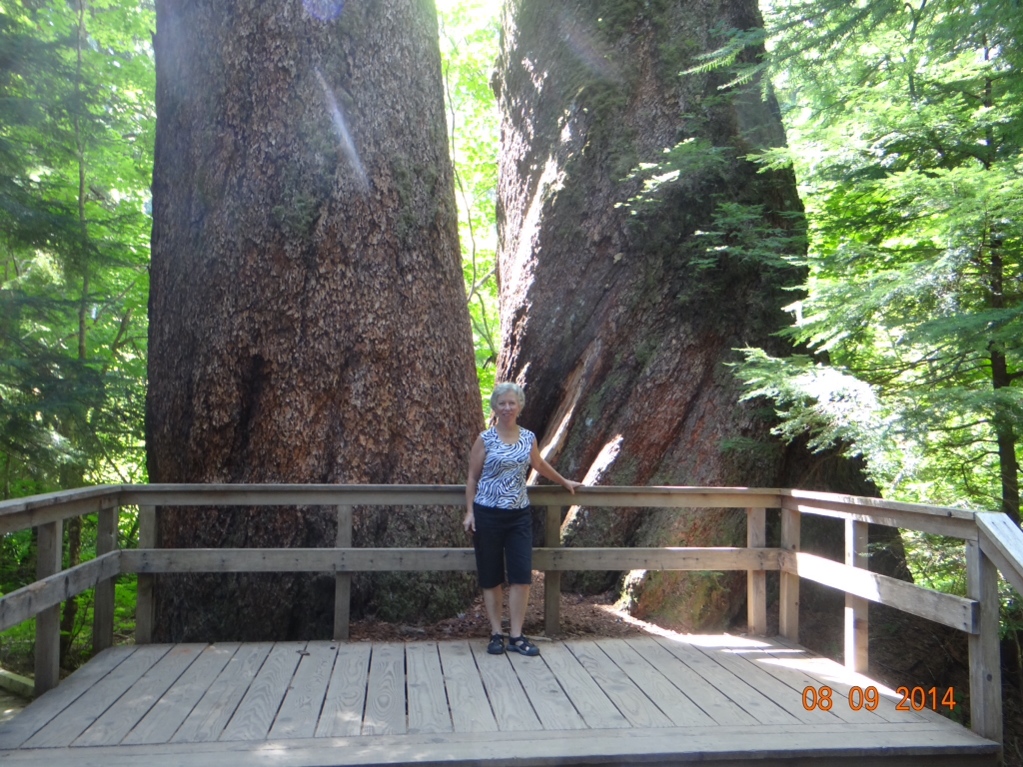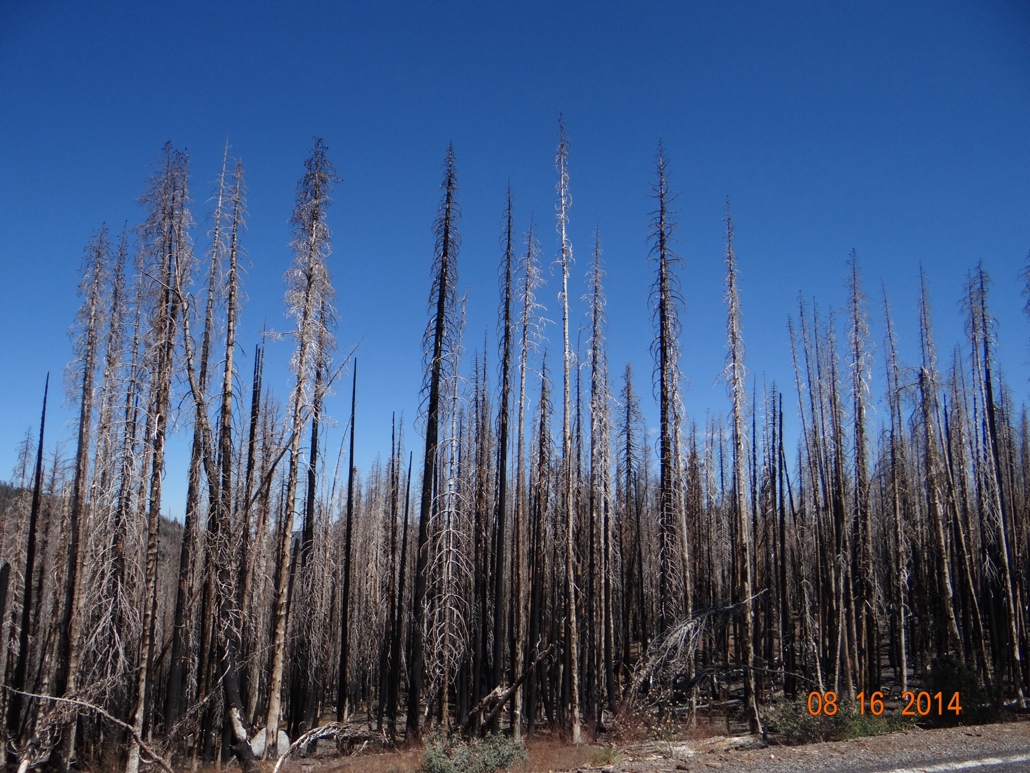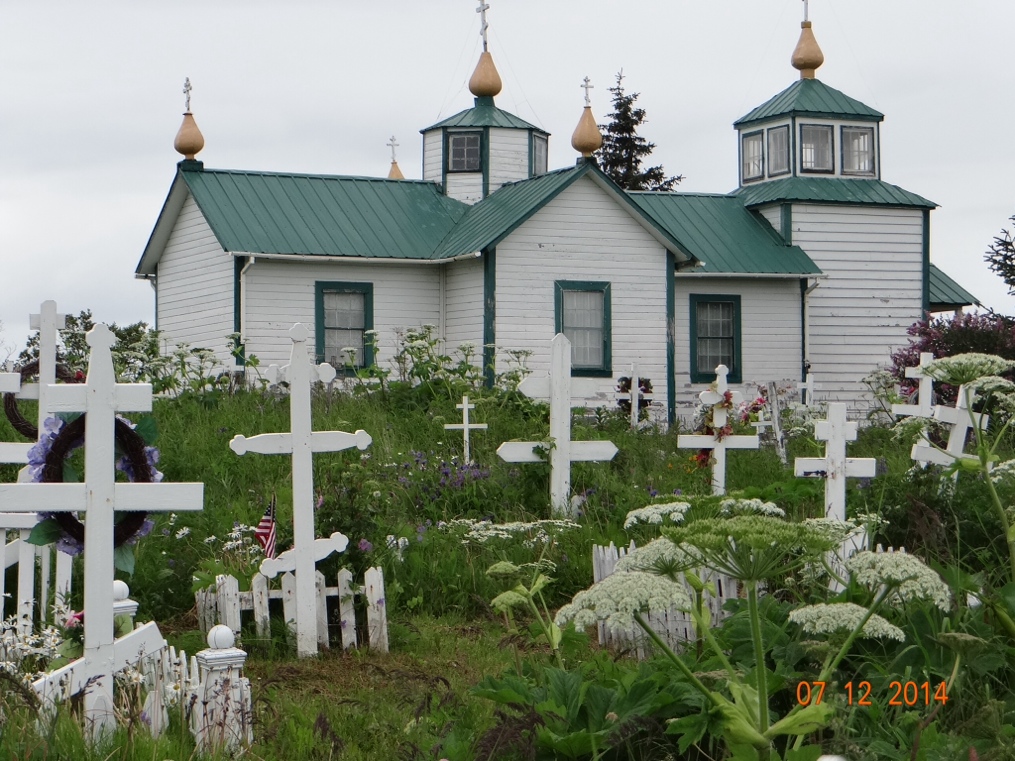As you drive south on Highway 99 in central California Yosemite National Park is about 50 miles to the east just before you pass through Fresno. Yosemite has entrances on both the west side of the park and on the south side. Sequoia and Kings Canyon National Parks are about 50 miles to the east after you pass through Fresno. We wanted to visit all three of these and Joan suggested that we camp north of Fresno, take the car to the west entrance to Yosemite, and then camp again south of Fresno and do the car trip to Sequoia and Kings Canyon. It was my idea to set up camp only once south of Fresno, and visit all three parks from there. I explained to Joan that this would save us the hassle of tearing down camp and setting up again, and by using the south entrance to Yosemite it would add only 15 to 20 minutes more to our trip into the park. Because I’m really the boss of the family, plus the fact that Joan has great faith in my planning abilities we camped south of Fresno.
On the day of the trip to Yosemite we got a bright and early start, and we were expecting a ride to the park entrance of 50-60 minutes. The park is huge and we thought it would take us all day to explore most of it by car. Since we were going to be gone all day, and we were not expecting to do a lot of hiking we took our dog, Daisy, along with us. Everything was fine until we got to within about 5 miles of the park entrance. There the Highway Patrol had a road block set up due to a forest fire at the park edge. They did not expect the road to open anytime soon, and directed us to go back a couple of miles and take an alternate route. I expected that this would be a short detour to get us around the fire and back onto the south road into the park. But as it turned out the detour was a road that took us all the way to western entrance to the park where Joan orginally wanted to enter. Furthermore, it extended our trip from our planned maximum of one hour to almost three hours. By the time we got there much of our day was shot. And it turned out that the Highway Patrol was right because the south entrance road did not open again all day. We ended up spending only about two hours exploring the park followed by another three hour drive back to the motorhome.
In spite of our troubles getting to and from Yosemite, and our shorter than expected stay, it was well worth visiting. This was my third trip to the park and Joan’s second. Unfortunately, we have never been there when the waterfalls are at their peak. This happens in the spring or early summer and we have always been there in late summer or fall. However, even without the added beauty of the very high waterfalls the scenery in the park is spectacular. My favorite view is of the granite dome known as Half Dome. It’s easy to see how they arrived at the name.

In the shadow of Half Dome are two other granite domes. I’m sure they also have their own names, but I have not been able to determine what they are called. So since this is MY blog and MY pictures I decided that I could name them MYSELF. I tried to come up with some clever way to work in some reference to the female anatomy, but could not do so. Therefore, I am just going to call these Sharon Domes in honor of my buxom friend in Kansas.
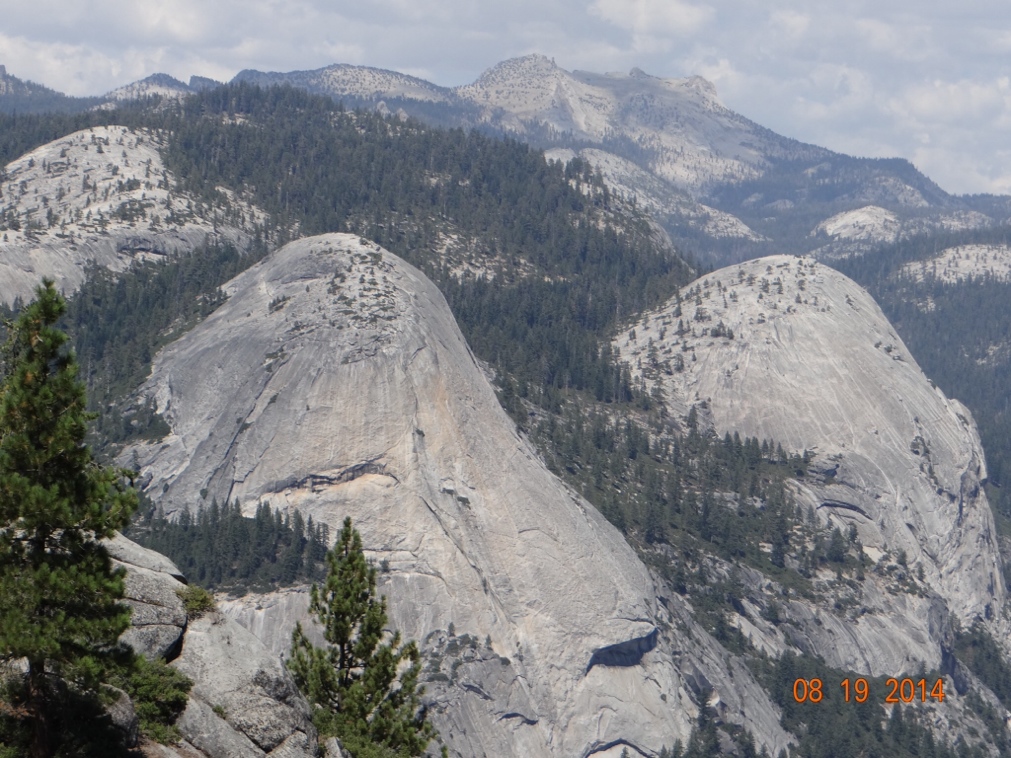
Sequioa and Kings Canyon National Parks are adjacent to each other, and therefore can be explored by car in a single day which is the way we did it. Joan and I had been to both parks before, but never seem to tire of enjoying the majesty of the giant trees. If you have never been to the western slopes of the Sierra Nevada mountains you have never seen Sequoia trees. This is the only place in the whole wide world that they grow. They are usually found at between 5,000 and 7,000 feet in elevation. They are so big because they grow very fast and live a long life. In fact the General Sherman tree is estimated to be 2,200 years old and it is still growing. Every year this tree grows enough new wood to produce a 60 foot tall tree of usual size. In general Sequoias can get to over 300 feet tall, live 3,200 years, and attain a 40 foot diameter at the base. This longevity is made possible by chemicals in the wood and bark providing resistance to insects and fungus. Further the thick bark (up to 31 inches thick) protects thenm from most fire. Most of them die by actually toppling over since they have a fairly shallow root system.


Not only do the Sequoias live a long time, but they also last a long time if toppled over. Just beside this fallen tree that Joan is looking into I saw a placque with a photo of some people posing in front of this same downed tree that was taken in 1900. And even though the photo was 114 years old the tree looked almost exactly as it looks today.

Joan and I both been to Kings Canyon previously, but had only visited it because it was next to Sequoia. Most people have heard of the Sequoias and want to see them, so they visit Sequoia and ignore Kings Canyon. But this time we took the time to actually drive down into the canyon. As a result Joan has a new favorite national park. This canyon is every bit as beautiful as the scenery in Yosemite and the actual canyon is deeper than the Grand Canyon. And what most people fail to realize when pondering a visit to the area is that they can also actually see very impressive Sequoia trees in Kings Canyon. In fact two of the above photos of the Sequoias were taken in Kings Canyon, and I thought the more impressive groves of trees were in Kings Canyon. The photo below of the actual canyon simply does not do it any justice.

From the Fresno area we finally turned eastward and eventually entered the Mojave Desert. Call me crazy (Joan does all the time!) but I just love the desert. Most people say it is too brown, too dry, too hot, etc, but I always enjoy my time there. However, I will admit that I always have enjoyed it from the air conditioned comfort of my vehicle with plenty of drinks handy. Driving east with an overnight stay in Needles, California and then on to Williams, Arizona really made me feel as though it signaled the beginning of the end of our journey. However, just a few miles north of Williams is this little hole in the ground that we wanted to revisit. Most people know it as the Grand Canyon. I think this is our fourth trip to Grand Canyon National Park and it never fails to awe. Probably lots of you have been to Grand Canyon, and you have your own memories of it, but I will include a couple of photos anyway. Unfortunately because of the wildfires in California it was not the clearest of days when we were there.
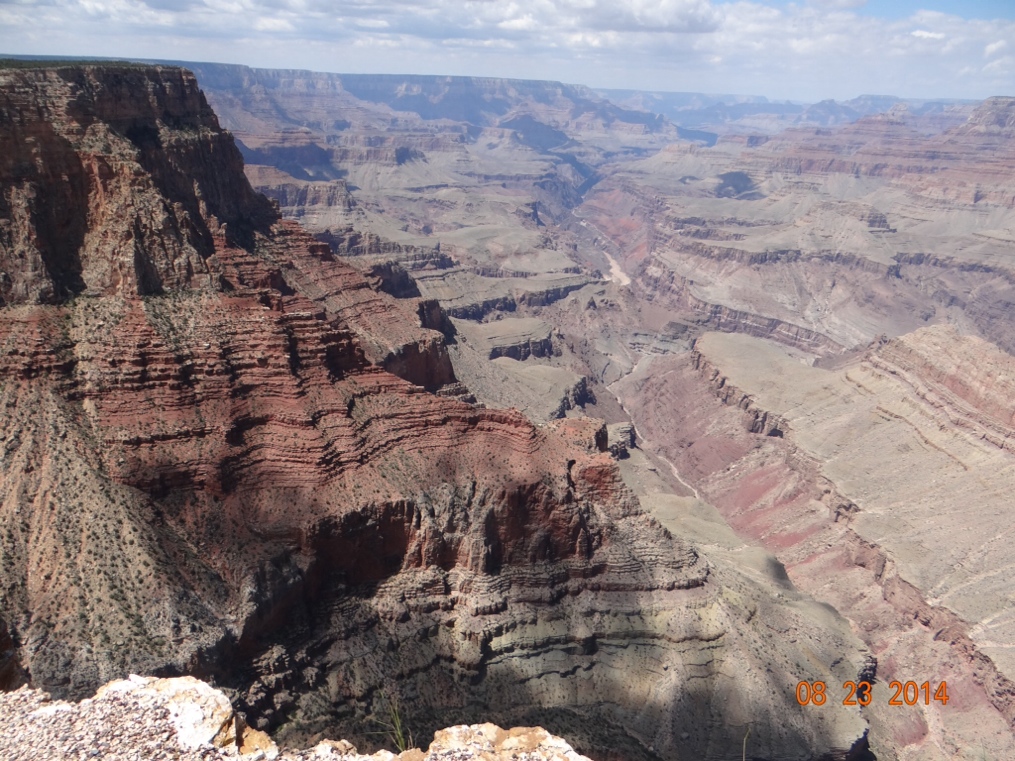

As we drive in the motorhome we both get caught up in our own thoughts along the way. A lot of my thinking as I drive involves what I am going to say in this blog about what I am seeing at the moment. At the beginning of our drive on the South Rim of the Grand Canyon I saw an elk crossing warning sign. And I had the following all worked out in my mind to write in this blog: “We have now driven the motorhome over 10,000 miles on this trip and we have driven the car at least 1,000 miles more. In that 11,000 miles we have seen dozens if not hundreds of warning signs for elk crossings. But we have not yet seen a single elk. Its not that we have never seen elk before. A few years ago we stayed overnight in Estes Park, Colorado and the elk were so thick in town that they were a real nuisance. All of the residents had their trees and shrubs protected with chicken wire, and the bugling was so loud at night that we could not sleep. But on this trip we have been in elk country for months and Grand Canyon is probably the very last likely spot that we could actually encounter an elk before we get back home in Florida.” Okay, that’s what I was going to write, but now I’m not. And here’s the reason.
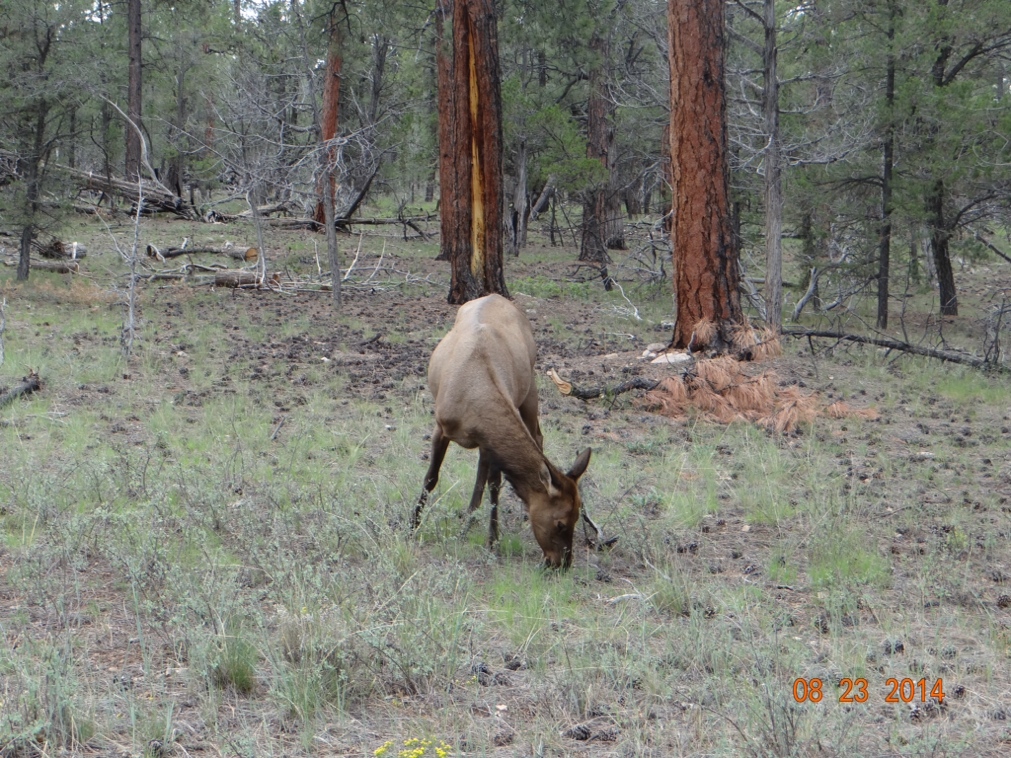
Just as we were leaving the national park we spotted this puny little guy (or girl) beside the road. No rack, it wouldn’t even look up at us for a photo op, and it ruined my opportunity to whine about not seeing any elk.
From Williams and the Grand Canyon we moved just a few miles south to Camp Verde, Arizona, and spent two days visiting our friend Edna. She informed me that she is not actually 150 years old as I wrote in the previous post, but just had her 88th birthday. While in Camp Verde we also visited the Montezuma’s Castle National Monument and Tuzigoot National Monument (all of the weird names for places don’t come from Washington State). These are both ancient Indian ruins and the castle is especially well preserved and was built right into the side of a cliff.

At Tuzigoot I could not resist buying myself a new hat to go with my newly longer and bushier beard. I like my new look for places with names such as Deadwood or Tombstone. Or even El Paso. It probably is not the best look for the beach, but we’ll see.
 From Camp Verde we moved on to Tucson, Arizona which is where I am writing this from. Tucson is one of my favorite little cities. I mentioned earlier how much I like the desert and Tucson lies right in the Sonoran Desert. We are spending eight nights in Tucson and getting a few minor repairs done on little problems that have cropped up after living in the motorhome for four months. Just outside of the city we have visited the eastern and western sections of Saguaro National Park. It’s not the best time of year to catch the cactus in bloom, but the variety of cacti all in one place make it interesting and there are a few that are presently in bloom such as the Barrel Cactus.
From Camp Verde we moved on to Tucson, Arizona which is where I am writing this from. Tucson is one of my favorite little cities. I mentioned earlier how much I like the desert and Tucson lies right in the Sonoran Desert. We are spending eight nights in Tucson and getting a few minor repairs done on little problems that have cropped up after living in the motorhome for four months. Just outside of the city we have visited the eastern and western sections of Saguaro National Park. It’s not the best time of year to catch the cactus in bloom, but the variety of cacti all in one place make it interesting and there are a few that are presently in bloom such as the Barrel Cactus.

You never know what kind of cactus you might spot in the area. For instance just outside of the visitor center for the park I spotted this perfect example of the non-prickly common fire plug cactus. Note the unusual coloring of this example though.
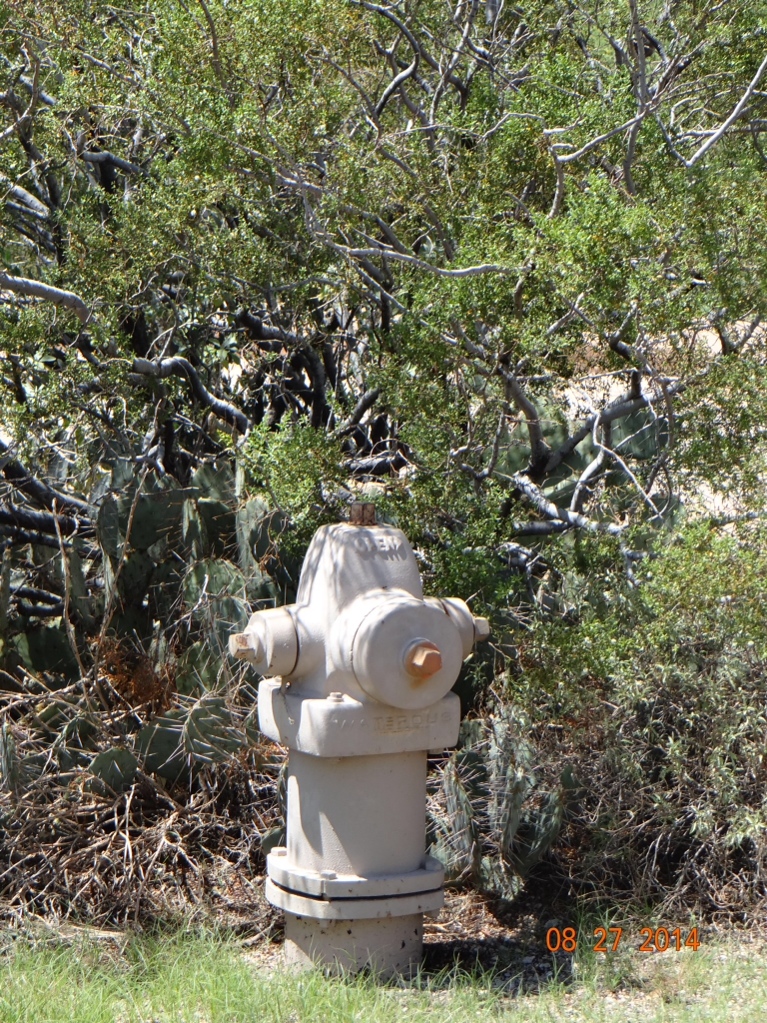
I’m especially fond of the Saguaro. They do not live as long as the Sequoias, but still the mature Saguaro can be 250 years old. And in the national park here they are everywhere.

If you have ever wondered why a few of the Saguaro have a downturned arm such as the one in the above photo, it is my understanding that this means that at some point in their long lives they have been exposed to a freeze. Since I’ve always been here in the summer I don’t think of it being cold and freezing in Tucson, but I guess it does happen.
Another phenomenon that appeals to me about the Tucson area is the varied climate around the city. Yesterday it was 100 degrees in the city which sits in a valley. Just forty miles outside of town we drove up to Mount Lemmon, a popular winter skiing area. Mount Lemmon sits at 8,000 feet elevation. As you drive out of the city you drive through a virtual forest of Saguaro until you reach about 4,000 feet. At that point the Saguaro disappear and are replaced by high desert plants such as Creosote bushes. Then as you continue to climb toward 8,000 feet you enter a pine forest and you would think you are now in a northern locale. Yesterday when we reached the summit it was 63 degrees. As we drove back down the mountain the temperature climbed steadily, but it was no longer in the triple digits upon arrival in the valley. It had dropped to a more reasonable 98 degrees. Much better!!


From Tucson I am expecting us to pretty much make a beeline to Houston. Joan thought we would be there for the August 6 first birthday of the twin grandbabies, Audrey and Andrew. Obviously, we did not make that! We are getting anxious to see them. For my Florida friends who were concerned about Audrey’s eating problems in her earlier months, be advised that she is now doing fine. She and Andrew are both walking now.


